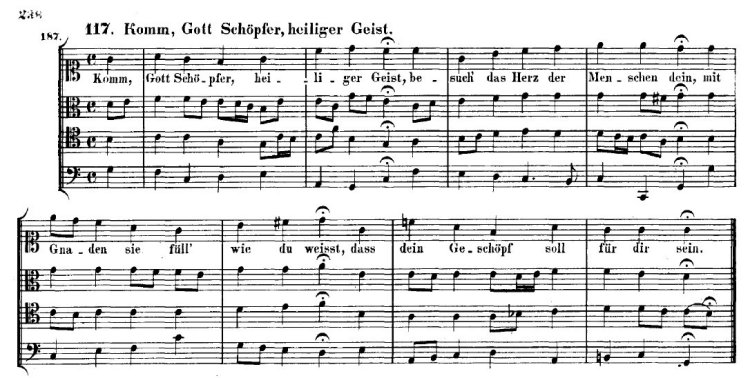|
Chorale Melodies used in Bach's Vocal Works
Komm, Gott Schöpfer, Heiliger Geist |
|
Melody & Text | Use of the CM by Bach | Use of the CM by other composers |
| |
|
Melody & Text: |
|
"Komm, Gott Schöpfer, Heiliger Geist" ("Come, God Creator, Holy Ghost") is a Lutheran hymn for Pentecost, with words written by Martin Luther as a paraphrase of the Latin "Veni Creator Spiritus". He wrote the hymn in his effort to establish German equivalents to the Latin parts of the liturgy. He derived the melody from the chant of the Latin hymn. The hymn in seven stanzas was first published with the melody in 1524, both in the Erfurt Enchiridion and in a setting by Johann Walter in Eyn geystlich Gesangk Buchleyn. The number in the current Protestant hymnal Evangelisches Gesangbuch (EG) is 126.
Source: Wikipedia (March 19, 2018) |
|
Melody: Zahn 295
Composer: Martin Luther (1529), based on the melody of the Latin hymn "Veni Creator Spiritus" (Kempten, 1000) |
|
In Klug’s Hymn-book (1535 [1529]) the melody, considerably modified , approached the form in which it is universally known. |
 |
|
Text: Komm, Gott Schöpfer, Heiliger Geist (EKG 97; EG 126; KGEL 132)
Author: Martin Luther (1524), based on the Latin hymn "Veni Creator Spiritus" by Rabanus Maurus (9th century) |
| |
| |
|
Use of the Chorale Melody by Bach: |
|
In the Cantata “Gott der Hoffnung erfulle euch,” (BWV 218) attributed to J.S. Bach (actually by Georg Philipp Telemann), the tune is used exactly in its 1535 form. Elsewhere, in Choralgesange, No. 218, and the two Organ movements (infra), J.S. Bach follows a version of the melody based on Johann Crüger’s text (1640) (supra) invariably for the third phrase. Witt (No. 171) exactly conforms to the 1535 text.
Bach treats the melody in two Organ movements:
N. xv. 97 (BWV 631). The movement is the only completed Prelude in the Whitsun section of the Orgelbüchlein. The similarity of its Bass to that of the four-part setting in the Choralgesange suggests that they were written in close association.
Spitta finds the movement out of place among Preludes in which Bach undertook to treat the Pedal uniformly obbligato throughout. He regards it as the fragment of a movement conceived on a much bigger scale - in fact, an introduction to No. 83 infra.
An older reading of the movement is in P.vii.86(A), whose original is in the Mendelssohn Autograph.
N. xvii. 82 (BWV 667). The movement is among the Eighteen Chorals and is the Orgelbüchlein Prelude with the addition of another verse, in which the cantus is on the Pedal. Its treatment suggests that Bach had in mind Acts ii. 2, 3: “And suddenly there came a sound from heaven.....And there appeared unto them cloven tongues like as of fire.”
Charles Sanford Terry: Bach’s Chorals, vol. 3 The Hymns and Hymn Melodies of the Organ Works (Cambridge University Press, 1921), pp 218-220 |
|
Text: Komm, Gott Schöpfer, Heiliger Geist
Author: Martin Luther |
|
Chorale Komm, Gatt Schöpler, heiliger Geist (Mvt. 5) from Cantata BWV 218 (by Georg Philipp Telemann) (verse 1) |
 |
|
Chorale Komm, Gott Schöpfer, heiliger Geist, BWV 370
Ref: Ri 187; Br 187; AmB 46II p.98 & p.154; Penzel 145; BC F125.1 |
 |
|
Untexted: |
|
Chorale Prelude Komm, Gott Schöpfer, heiliger Geist (I), BWV 631 |
| |
|
Chorale Prelude Komm, Gott Schöpfer, heiliger Geist (II), BWV 631a |
| |
|
Chorale Prelude Komm, Gott Schöpfer, heiliger Geist (III), BWV 667 |
| |
| |
| |
|
Use of the Chorale Melody by other composers: |
|
Arnold Schoenberg arranged the partita (BWV 667) for large orchestra in 1922. |
|
In the 1860's, a motet for women's voices to the Latin text was among the last works of Hector Berlioz (H 141), and Anton Bruckner harmonized the original tune for voice and organ as his motet WAB 50 in the 1880's. Gustav Mahler set the Latin text to music in Part I of his Symphony No. 8 in E-flat major (1906). Maurice Duruflé used the chant tune as the basis for his symphonic organ composition Prélude, Adagio et Choral varié sur le thème du 'Veni Creator in 1926/1930. Paul Hindemith concluded his 1962 Concerto for Organ and Orchestra with a Phantasy on "Veni Creator Spiritus." Krzysztof Penderecki wrote a motet for mixed choir (1987), and the text has been set for chorus and orchestra by Cristóbal Halffter (1992). Karlheinz Stockhausen used the text in the second hour of his Klang cycle in a 2005 piece for two singing harpists titled Freude (Joy). |
| |
| |
|
Sources: Bach Digital; BGA; Zahn; Wikipedia (March 19, 2018); Source: Charles Sanford Terry: Bach’s Chorals, vol. 3 The Hymns and Hymn Melodies of the Organ Works (Cambridge University Press, 1921), pp 218-220
Prepared by Aryeh Oron (October 2018) |